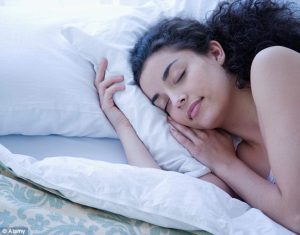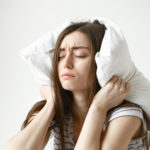White noise machines made their way out of the nursery and into the master bedroom quite a while ago. It seems counterintuitive to create a bunch of noise to help someone fall asleep. We come across hundreds on the internet each day, who swear that they cannot sleep without the TV or radio on. Most city folks need some constant low noise to help them sleep through the night.

What is white noise?
What level of noise is conducive to sleep? Exactly how loud or how low does the sound have to be for someone to feel sleepy? What do our brains and ears like about noise so much?
Several investigations on sleep quality and noise show that white noise helps us get the best sleep. White noise has two defining attributes –
- It is consistent
- It is audible across all frequencies
White noise has the power to mask the effects of sudden changes or noises that wake people up at night. Most often, light sleepers wake up due to changes in the crescendo-decrescendo of their sleeping partner’s snoring. The masking effect of white noise helps light sleepers. Explore Jinglow to learn more about the impact of white noise on sleep.
According to researchers, the hearing has evolved among the mammals as an alarm system. For example – women’s ears are more accustomed towards high-frequency noises that are akin to a baby’s crying. Evolution has shaped our ability to hear certain types of sounds better than the others. This “alarm system” is active even when we are asleep. Therefore, light sleepers are sensitive towards the inconsistencies of frequency chances or intensity alterations like sudden honking.
What are the familiar sources of white noise people experience each day?
Over the years, people have come to refer to a number of noise sources as white noise. It has become an everyday term that describes many continuous noise types that people often experience in the immediate surroundings –
- Sounds of rain, waves or the sea, natural noise inside a jungle and crickets chirping.
- Several types of machinery like the washing machine, ceiling fans and air conditioning units often give birth to continuous white noise inside households.
- Ambient soundscapes like crowds, crackling bonfires, and interior of an aircraft often have a continuous hum.
Do all people benefit from white noise?
There is a significant portion of the population that suffers from tinnitus 24*7. For these people, the upper notes of white noise can be quite disruptive for sleep. There are different groups of people, who prefer another “noise” group. Pink noise is a category of noise frequencies that have a lower intensity of high-frequency sounds. There is a rainbow of noise categories that includes brown noise, blue noise, violet noise and grey noise. The effects of other color noises on sleep quality are not as widely known as white noise, brown noise, and pink noise. Therefore, you could easily say that pink noise is a form of white noise that has selectively higher intensities for a few lower frequencies. On the other hand, all frequencies have equal power in the case of white noise.








It is true! In vacations, I struggle with the quietness! I miss the noise of the city!